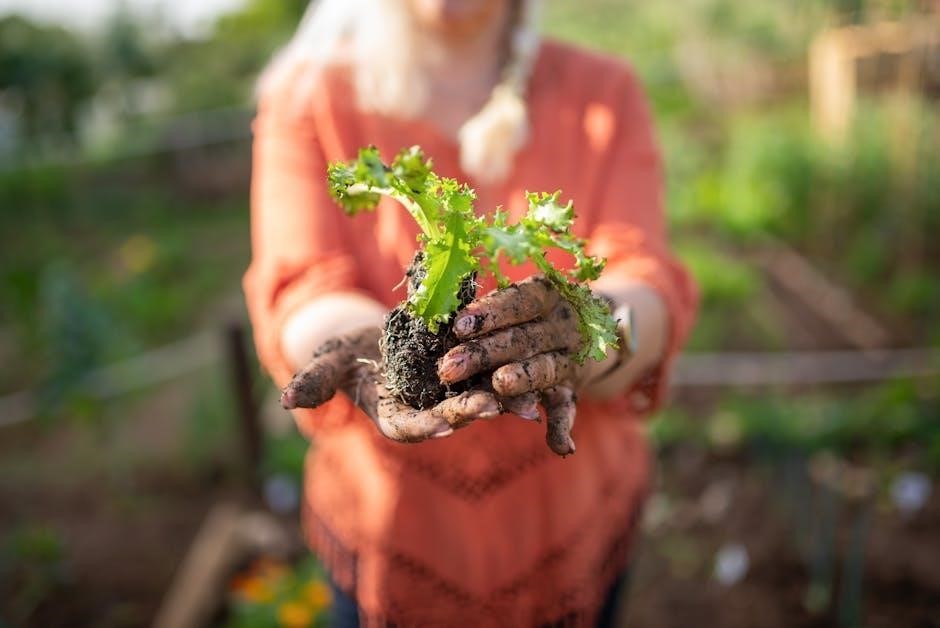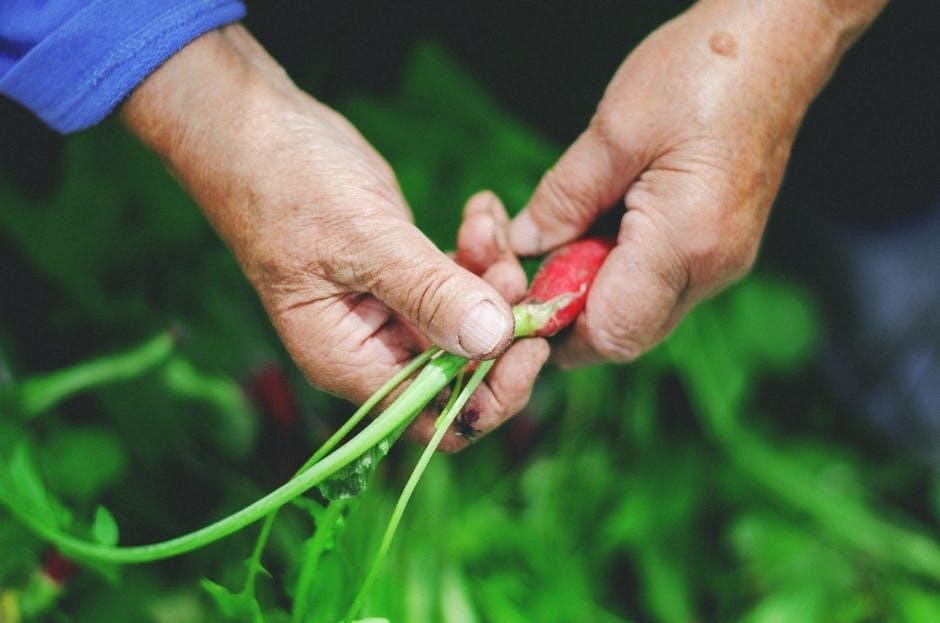A comprehensive guide tailored for gardeners in USDA Hardiness Zone 9b, offering detailed planting timelines and expert tips to maximize vegetable growth and productivity throughout the year.
1.1 Understanding USDA Hardiness Zone 9b
USDA Hardiness Zone 9b is defined by average minimum temperatures of 20°F to 30°F (-6.7°C to -1.1°C). This zone offers a long growing season, ideal for year-round gardening. Regions like California, Texas, and Florida fall into Zone 9b, allowing gardeners to grow a wide variety of vegetables and plants throughout the year due to its warm climate.
1.2 Importance of a Planting Schedule for Zone 9b
A planting schedule is crucial for Zone 9b gardeners to optimize growth and productivity. It ensures vegetables are planted at the right time, avoiding frost and extreme heat. This guide helps maximize the long growing season, allowing gardeners to enjoy year-round harvests and make informed decisions on planting times for specific crops.
Climate Overview of Zone 9b
Zone 9b enjoys warm temperatures year-round, with average minimum temps of 25-30°F, ideal for extended growing seasons and diverse vegetable cultivation.
2.1 Temperature Ranges and Growing Seasons
Zone 9b experiences warm temperatures year-round, with average minimums ranging from 25°F to 30°F. The long growing season allows for multiple harvests, including spring, summer, and fall/winter crops. Gardeners can plant cool-season vegetables in early spring or late summer and warm-season varieties during the hot months, making Zone 9b ideal for year-round vegetable gardening.
2.2 Annual Frost Dates and Their Impact on Planting
In Zone 9b, frost dates are minimal, typically occurring between mid-November and late January. These dates are crucial for planting schedules, as they determine when to start or avoid planting sensitive crops. Gardeners should plan accordingly to protect tender vegetables during frost periods, ensuring optimal growth and avoiding damage to plants.

Best Vegetables for Zone 9b
Zone 9b offers ideal conditions for growing a variety of vegetables year-round, including tomatoes, peppers, zucchini, spinach, carrots, and green beans, making it a gardener’s paradise.
3.1 Spring Vegetables
Zone 9b’s mild winters and warm springs make it ideal for growing a variety of spring vegetables. Tomatoes, peppers, zucchini, and spinach thrive in the region’s sunny and temperate climate. Carrots, green beans, and radishes also excel, benefiting from the long growing season. Plant these vegetables in early spring for a bountiful harvest, ensuring healthy growth with proper care and timing.
3.2 Summer Vegetables
Zone 9b’s warm weather is perfect for growing summer vegetables. Popular choices include tomatoes, peppers, cucumbers, squash, eggplants, okra, and corn. These vegetables thrive in the region’s long, sunny season. Plant heat-tolerant varieties, ensure consistent moisture, and provide shade if temperatures soar. Proper care ensures a productive summer harvest in Zone 9b gardens.
3.3 Fall and Winter Vegetables
Zone 9b’s mild winters make it ideal for growing fall and winter vegetables. Broccoli, kale, spinach, carrots, Brussels sprouts, and radishes thrive in cooler weather. Plant seeds in late summer or early fall for a winter harvest. Soil preparation and frost protection are key to successful growth during these seasons in Zone 9b gardens.
Planting Calendar for Zone 9b
Zone 9b’s long growing season allows for year-round gardening. Start seeds indoors in late winter, transplant in early spring, and enjoy multiple harvests throughout the year.
4.1 When to Start Seeds Indoors
In Zone 9b, start seeds indoors 8-10 weeks before the last frost date. Use high-quality seed starting mix and maintain consistent moisture. Optimal germination temperatures vary by plant, typically between 65-85°F. Provide adequate light, such as grow lights, after germination. Harden off seedlings before transplanting outdoors for a successful transition to the garden.
4.2 When to Transplant Outdoors
In Zone 9b, transplant seedlings outdoors after the last frost date, typically in early April. Ensure soil has warmed to optimal temperatures for root growth. For warm-season crops like tomatoes and peppers, wait until late April to early May. Cool-season crops like lettuce can be transplanted in late March. Harden off seedlings for 7-10 days before transplanting to avoid shock.
Soil Preparation and Care
Test soil pH and amend with organic matter to improve structure. Use compost or aged manure to enhance fertility. Ensure proper drainage to prevent waterlogging and root rot.
5.1 Optimal Soil pH for Vegetables in Zone 9b
The optimal soil pH for vegetables in Zone 9b typically ranges from 6.0 to 7.0. Leafy greens and brassicas prefer a slightly lower pH, while tomatoes and peppers thrive around 6.5. Root vegetables like carrots and beets also favor this range. Maintaining this balance ensures healthy microbial activity, nutrient availability, and root development, which are crucial for robust plant growth and high yields.
5.2 Fertilization and Mulching Tips
For Zone 9b gardens, use balanced fertilizers (10-10-10) to promote healthy plant growth. Apply compost or well-rotted manure at planting time for organic matter. Mulch with organic materials like straw or bark chips to retain moisture, suppress weeds, and regulate soil temperature. Maintain a 2-3 inch layer of mulch around plants, keeping it a few inches away from stems to prevent rot and pests.
Watering and Irrigation
Zone 9b gardens require consistent moisture due to warm temperatures. Water vegetables deeply 2-3 times weekly, avoiding waterlogged soil. Use drip irrigation or soaker hoses for efficiency.
6.1 Watering Frequency for Zone 9b Vegetables
Vegetables in Zone 9b require consistent watering due to the warm climate. Water deeply 2-3 times a week, ensuring soil stays moist but not waterlogged. Adjust frequency during extreme heat or rainfall. Drip irrigation and mulching help retain moisture and reduce evaporation, promoting healthy plant growth throughout the growing season.
6.2 Efficient Irrigation Methods
Implementing efficient irrigation in Zone 9b is crucial for optimal water use. Drip irrigation systems minimize evaporation and deliver water directly to roots. Soaker hoses and mulching also conserve water by reducing runoff. Timed sprinklers ensure consistent watering schedules, while rain barrels collect and store rainwater for sustainable garden maintenance.

Pest and Disease Management
Effectively managing pests and diseases in Zone 9b requires strategies to combat aphids and powdery mildew while maintaining healthy soil and plant hygiene.
7.1 Common Pests in Zone 9b Gardens
Zone 9b gardens often face challenges from pests like aphids, whiteflies, and hornworms. These insects can damage plants and reduce yields. Regular monitoring and organic control methods, such as neem oil and beneficial insects, are essential to maintain healthy crops and prevent infestations from spreading.
7.2 Preventing Diseases in Vegetables
Preventing diseases in Zone 9b vegetables involves practices like crop rotation, removing infected plants, and ensuring good air circulation. Using disease-resistant varieties and treating seeds before planting can also minimize fungal and bacterial issues. Regular watering schedules and balanced fertilization further support plant health, reducing susceptibility to common diseases.
Succession Planting in Zone 9b
Succession planting in Zone 9b maximizes garden productivity by growing multiple crops in the same space. The warm climate allows for several harvests, making planning essential for optimal growth.
8.1 How to Plan Succession Crops
Planning succession crops in Zone 9b involves selecting varieties with shorter maturation periods and staggering planting dates. Start with cool-season crops in early spring, transition to warm-season varieties in summer, and finish with fall crops. Ensure adequate spacing and timing between plantings to avoid competition. Use a Zone 9b planting schedule PDF for precise timing and crop rotation guidance to maximize yields and maintain soil health.
8.2 Benefits of Continuous Harvests
Continuous harvests in Zone 9b offer year-round vegetable production, maximizing garden space and ensuring a steady food supply. This method prevents soil depletion, reduces pests, and optimizes water use. By following a Zone 9b planting schedule PDF, gardeners can enjoy fresh produce in every season, enhancing productivity and sustainability in their gardening efforts.

Using a Zone 9b Planting Schedule PDF
A Zone 9b planting schedule PDF provides a structured guide for optimal vegetable gardening, detailing planting times, care tips, and space management for year-round productivity and success.
9.1 Where to Find Reliable PDF Guides
Reliable Zone 9b planting schedule PDFs can be found on trusted gardening websites, USDA resources, and local nursery sites. These guides are often free or low-cost, offering detailed planting calendars, soil tips, and specific advice for maximizing vegetable growth in Zone 9b’s unique climate conditions year-round.
9.2 How to Use the Schedule Effectively
To use the Zone 9b planting schedule effectively, start by understanding the layout and key planting dates. Plan your garden layout based on spacing and sunlight needs. Track progress and adjust for weather variations. Refer to the schedule regularly to ensure timely planting and harvesting. Combine it with local advice for optimal results tailored to your specific growing conditions.

Common Mistakes to Avoid
Avoid planting too early or late, ignoring soil preparation, and overwatering. These errors can reduce yields and plant health in Zone 9b gardens.
10.1 Planting Too Early or Too Late
Planting too early exposes crops to frost, while planting too late misses optimal growing windows. In Zone 9b, warm temperatures allow year-round gardening, but timing must align with vegetable specific needs. Using a planting schedule PDF ensures proper timing, avoiding frost risks for cool-season crops and heat stress for warm-season varieties. Check average frost dates to avoid early or late planting errors.
10.2 Overwatering or Underwatering
Zone 9b’s warm climate makes watering crucial. Overwatering can cause root rot and nutrient leaching, while underwatering leads to stressed plants. Check soil moisture by hand, water deeply but infrequently, and use drip irrigation to avoid foliage wetness. Mulch helps retain moisture and regulate soil temperature, ensuring vegetables thrive without water-related issues in Zone 9b’s climate.
Gardening in Zone 9b offers year-round opportunities with proper planning. By following a planting schedule, gardeners can enjoy optimal growth, abundant harvests, and the joy of nurturing their plants.
11.1 Summary of Key Tips for Zone 9b Vegetable Gardening
Zone 9b gardening thrives with warm temperatures and year-round growth. Plant vegetables suited to each season, prepare soil with optimal pH, water efficiently, and manage pests. Succession planting maximizes harvests, while following a planting schedule ensures timely results. Regular fertilization and mulching support healthy growth. Refer to a Zone 9b planting schedule PDF for precise guidance and enjoy a bountiful garden.
11.2 Encouragement to Start Gardening in Zone 9b
Gardening in Zone 9b offers a unique opportunity to grow vegetables year-round due to its mild winters and warm summers. With proper planning and care, even beginners can achieve a thriving garden. Embrace the joy of nurturing your plants and enjoying fresh, homegrown produce. Start small, stay consistent, and let the rewarding experience of gardening in Zone 9b inspire you to continue growing!

Leave a Reply
You must be logged in to post a comment.